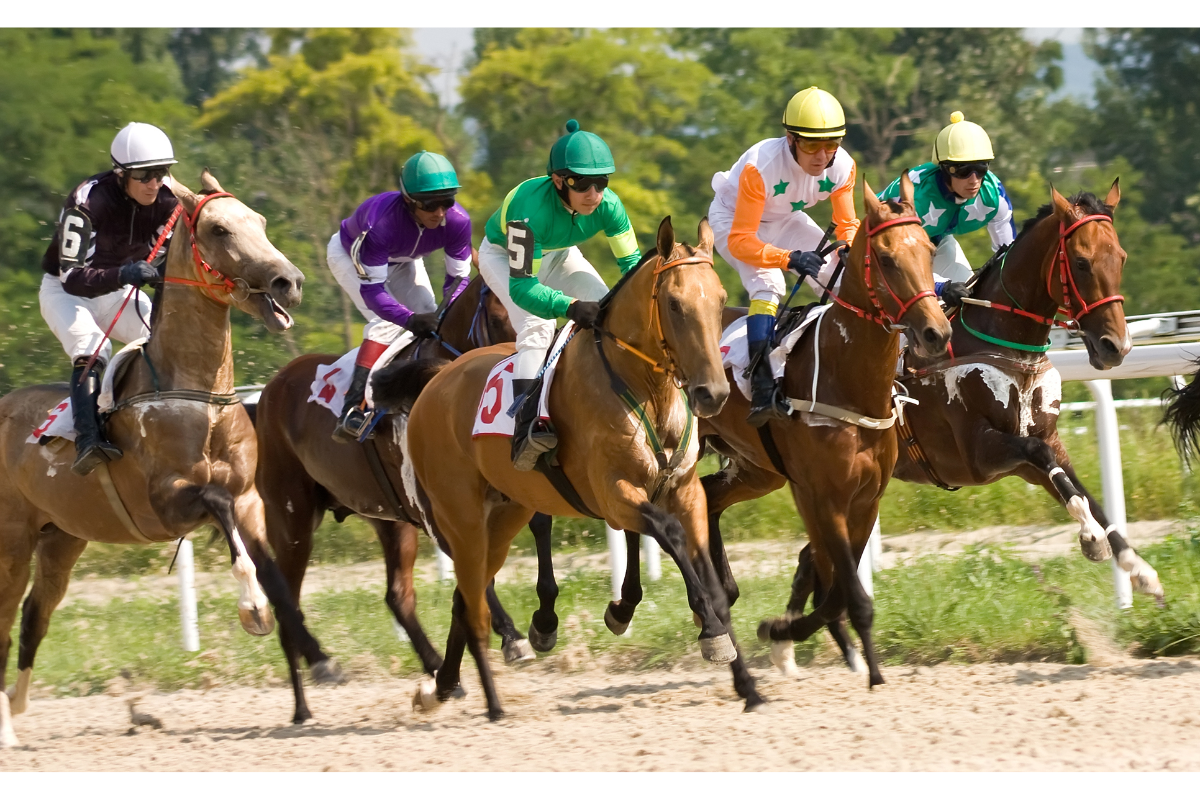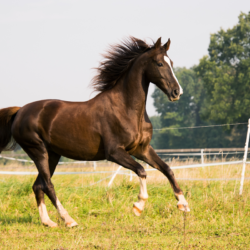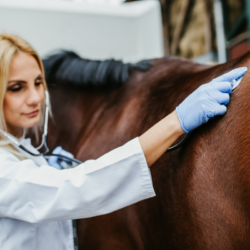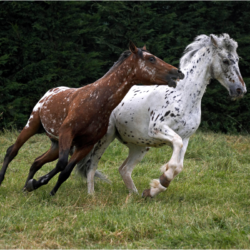Blood stroke, also known as rhabdomyolysis in horses, is a serious pathological condition affecting the skeletal muscles of equines. Characterised by the rapid destruction of muscle cells, this syndrome can lead to severe pain, stiffness and locomotor disability. Horse owners and vets need to be aware of the warning signs and understand the risk factors to effectively manage and prevent this condition.
What is bloodshot syndrome?
Coup de sang refers to a group of clinical signs that appear in horses when the muscles of the back and croup are suddenly affected by exercise or stress. This syndrome, also known as exercise-induced rhabdomyolysis, is characterised by acute destruction of the lumbar and buttock muscles following physical exertion or stress (transport, travel, etc.).
It can occur occasionally or repeatedly in horses. Also known as “Monday sickness”, this condition often occurs after a return to work following a period of rest. The term myositis, although common, is technically inappropriate as it refers to inflammation of the muscles.
Clinical signs vary according to the severity of muscle destruction:
Muscle signs :
- Stiffness of the hind legs, difficulty engaging the hind legs
- Lameness
- Reluctance or refusal to move forward
- Induration and pain on palpation of the buttock and lumbar muscles
- Trembling or muscle spasms
- Hunched posture
General signs :
- Exercise intolerance, poor performance
- Heavy sweating
- Hyperthermia (rectal temperature > 38.5°C)
- Increased heart and respiratory rates in cases of intense pain
- Dark urine in severe forms (presence of myoglobin)
These signs may appear during or just after even moderate exercise or stress.
Compared with human cramps, equine myositis is generally extremely painful and not localised to a single area. This pathology can seriously hamper a horse’s sporting career, requiring periods of rest and potentially leaving serious after-effects. A distinction is made between sporadic rhabdomyolysis, caused by excessive exercise, and chronic or recurrent rhabdomyolysis, often linked to hereditary abnormalities.
What causes rhabdomyolysis?
There are two types of exercise-induced rhabdomyolysis:
- Occasional rhabdomyolysis: caused by environmental factors.
- Chronic or recurrent rhabdomyolysis: linked to problems inherent in the horse, exacerbated by environmental factors.
Exercise-induced rhabdomyolysis occurs mainly in the following situations:
- Exercise that is too intense for the horse’s physical condition.
- Excessively demanding or stressful exercise.
- Over-training.
- Endurance racing in hot, humid conditions.
- Diet too rich in concentrates, especially after days of rest without a reduction in the ration.
- An unbalanced diet in terms of vitamins and minerals.
Chronic or recurrent rhabdomyolysis results from genetic predisposition. Known forms include :
- PSSM (PolySaccharide Storage Myopathy): abnormal storage of glucose in the form of unusable polysaccharides. Affects many breeds.
- RER (Recurrent Exertional Rhabdomyolysis): faulty regulation of intracellular calcium, mainly affecting thoroughbreds and trotters.
- Myofibrillar myopathy: disorganisation of the myofibrils, affecting sport breeds and Arabian horses.
- Malignant hyperthermia: affects Quarter Horses and associated breeds (Paint, Appaloosa).
If clinically suspected, a blood test can confirm the diagnosis, revealing elevated levels of creatine kinase (CK ) and aspartate amino transferase (ASAT).
In the event of repeated attacks with no identified cause, the veterinary surgeon may carry out :
- Muscle biopsy to detect abnormalities.
- Genetic tests (available for PSSM type 1 and malignant hyperthermia).
The vet will confirm the diagnosis by taking a blood sample and will assess the severity of the seizure in order to adapt the treatment and follow-up.
How can I prevent a blood attack?
Exercise must be regular and adapted to the horse’s age and physical condition.Training should include a sufficient warm-up, periods of rest and muscular relaxation, and a period of active recovery after work. Avoid confinement to the stall. For nervous young horses, the environment and stress management are crucial. A regular work routine and timetable is recommended for horses prone to fits.
Feed should be adapted to the workload. Carbohydrates can be replaced by fats. For horses in light work, a diet of quality hay may suffice. In hot weather or after heavy sweating, add electrolytes to the feed or water.
For horses with recurrent blood strokes, it is vital to look for a genetic disease so that boarding, working and feeding can be adapted. Here are the main measures for preventing myositis:
- Adapt exercise to the horse’s age, training and physical condition.
- Start the sessions by relaxing and finish by calming down.
- After intense exercise or a competition, offer rest.
- After a break, resume exercise gradually.
- Provide plenty of water and a salt stone.
- Allow the horse to walk regularly, with daily outings to the paddock or meadow.
Certain food supplements can be beneficial:
- In hot, humid weather, electrolytes help to compensate for losses through perspiration and promote hydration.
- For sensitive horses or during intense exercise,antioxidant-based supplements (vitamin E, selenium, SOD such as Myostem Protec) support muscle cells.
Myositis can affect a horse’s daily comfort and sporting performance.
How can you help your horse during a bout of bleeding?
Treatments include:
- Gentle diuretic care products.
- Anti-oxidant supplements.
- Electrolytes to compensate for sweating.
To treat blood stroke in horses, it is essential to follow certain steps. Avoid moving the horse so as not to aggravate the muscular destruction. If the horse moves on its own, place it in a calm, familiar environment. Rest is essential until the muscle enzymes have returned to normal, and the horse should resume work very gradually.
Be careful not to administer medication to a dehydrated animal, as this can damage the kidneys. If myositis is suspected, the vet can start various treatments even before the results of the blood test are available:
- Perfuse the horse to support the kidneys, dilute waste products in the blood and encourage the elimination of toxins through the urine.
- Use sedatives to relax the horse and loosen its muscles.
- Prescribe non-steroidal anti-inflammatories to relieve pain.
The vet will advise you on how to manage the recovery period. The horse will be rested and will not return to work until the symptoms have completely disappeared, generally between 15 days and a month after the attack. A draining cure during convalescence may be recommended. Diuretic supplements such as dandelion or milk thistle (e.g. Ekyrenal) can also help the horse recover.
For horses with chronic myositis, regular activity is recommended, as attacks are less severe. Avoid moving the horse on foot, even for short distances; use a van or lorry. Keep the horse cool to prevent thermal shock. Prepare the horse for the effort it will have to put in with appropriate training and ensure a good balance between feed and effort.





